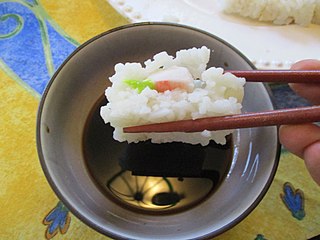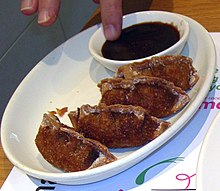
Cantonese or Guangdong cuisine, also known as Yue cuisine is the cuisine of Guangdong province of China, particularly the provincial capital Guangzhou, and the surrounding regions in the Pearl River Delta including Hong Kong and Macau. Strictly speaking, Cantonese cuisine is the cuisine of Guangzhou or of Cantonese speakers, but it often includes the cooking styles of all the speakers of Yue Chinese languages in Guangdong.

Vietnamese cuisine encompasses the foods and beverages of Vietnam. Meals feature a combination of five fundamental tastes : sweet, salty, bitter, sour, and spicy. The distinctive nature of each dish reflects one or more elements, which are also based around a five-pronged philosophy. Vietnamese recipes use ingredients like lemongrass, ginger, mint, Vietnamese mint, long coriander, Saigon cinnamon, bird's eye chili, lime, and Thai basil leaves. Traditional Vietnamese cooking has often been characterised as using fresh ingredients, not using much dairy or oil, having interesting textures, and making use of herbs and vegetables. The cuisine is also low in sugar and is almost always naturally gluten-free, as many of the dishes are rice-based instead of wheat-based, made with rice noodles, papers and flour. Vietnamese cuisine is strongly influenced not only by the cuisines of neighboring China, Cambodia and Laos, but also by French cuisine due to French colonial rule over the region from 1887 to 1954.
Sweet and sour is a generic term that encompasses many styles of sauce, cuisine, and cooking methods. It is commonly used in East Asia and Southeast Asia and has been used in England since the Middle Ages. Sweet and sour sauce remains popular in Asian and Western cuisines.

Plum sauce is a viscous, light-brown sweet and sour condiment. It is used in Cantonese cuisine as a dip for deep-fried dishes, such as spring rolls, noodles, and deep-fried chicken balls as well as for roast duck. It is made from sweet plums or other fruit such as peach, pineapple or apricot, along with sugar, vinegar, salt, ginger and chili peppers.

A dip or dip sauce is a common condiment for many types of food. Dips are used to add flavor or texture to a food, such as pita bread, dumplings, crackers, chopped raw vegetables, fruits, seafood, cubed pieces of meat and cheese, potato chips, tortilla chips, falafel, and sometimes even whole sandwiches in the case of jus. Unlike other sauces, instead of applying the sauce to the food, the food is typically placed or dipped into the sauce.

Char siu is a Cantonese–style of barbecued pork. Originating in Guangdong, it is eaten with rice, used as an ingredient for noodle dishes or in stir fries, and as a filling for chasiu baau or pineapple buns. Five-spice powder is the primary spice, honey or other sweeteners are used as a glaze, and the characteristic red color comes from the red yeast rice when made traditionally.

Noodle soup refers to a variety of soups with noodles and other ingredients served in a light broth. Noodle soup is a common dish across East Asia, Southeast Asia and the Himalayan states of South Asia. Various types of noodles are used, such as rice noodles, wheat noodles and egg noodles.

Rice vermicelli is a thin form of noodle. It is sometimes referred to as "rice noodles" or "rice sticks", but should not be confused with cellophane noodles, a different Asian type of vermicelli made from mung bean starch or rice starch rather than rice grains themselves.

Chili sauce and chili paste are condiments prepared with chili peppers.

Nước chấm is a common name for a variety of Vietnamese "dipping sauces" that are served quite frequently as condiments. It is commonly a sweet, sour, salty, savoury and/or spicy sauce.

A rice noodle roll, also known as a steamed rice roll and cheung fun, and as look funn or look fun in Hawaii, is a Cantonese dish originating from Guangdong Province in southern China, commonly served as either a snack, small meal or variety of dim sum. It is a thin roll made from a wide strip of shahe fen, filled with shrimp, beef, vegetables, or other ingredients. Seasoned soy sauce – sometimes with siu mei drippings – is poured over the dish upon serving. When plain and made without filling, the rice noodle is also known as jyu cheung fun, literally "pork intestine noodle", a reference to its resemblance of a pig's intestines. There is no official recording of the history of rice noodle rolls; most cookbooks claim that it was first made in the 1930s. In Guangzhou, Guangdong Province, people called the dish laai cheung because it is a noodle roll that pulled by hand.

Japanese Chinese cuisine, also known as Chūka, represents a unique fusion of Japanese and Chinese culinary traditions that have evolved over the late 19th century and more recent times. This style, served predominantly by Chinese restaurants in Japan, stands distinct from the "authentic Chinese food" found in areas such as Yokohama Chinatown. Despite this difference, the cuisine retains strong influences from various Chinese culinary styles, as seen in the Shippoku cooking style.

Nem nướng is Vietnamese grilled pork sausage or grilled meatballs, and a popular Vietnamese food item, sometimes served as an individual appetizer or snack, or served with rice noodles or rice as a main course. Nem nướng is a specialty of Khánh Hòa Province . Nem nướng is a rustic dish, originating from Ninh Hoa, a northern district of Khanh Hoa province, about 30 km from the coastal city.

Spring rolls are rolled appetizers or dim sum commonly found in Chinese and Southeast Asian cuisines. The kind of wrapper, fillings, and cooking technique used, as well as the name, vary considerably depending on the region's culture, though they are generally filled with vegetables.

Mì (mỳ) or mi is a Vietnamese term for yellow wheat noodles. It can also refer to egg noodles. They were brought over to Vietnam as wonton noodles by Chinese immigrants. The Vietnamese version of wonton noodles is mì hoành thánh. The noodles can be either thin or wide and are commonly used in súp mì and mì khô.
















